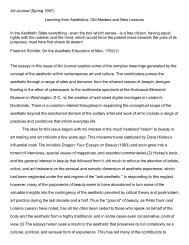Lessons in Futility: Francis Alÿs and the Legacy of ... - Grant Kester
Lessons in Futility: Francis Alÿs and the Legacy of ... - Grant Kester
Lessons in Futility: Francis Alÿs and the Legacy of ... - Grant Kester
You also want an ePaper? Increase the reach of your titles
YUMPU automatically turns print PDFs into web optimized ePapers that Google loves.
have told us). Mean<strong>in</strong>g is less negated <strong>in</strong> this gesture than it is temporally<br />
displaced through a semantic relay. The ambiguity required <strong>of</strong> a poetic text is<br />
<strong>the</strong>n collapsed <strong>in</strong>to <strong>the</strong> content <strong>of</strong> <strong>the</strong> work, through <strong>the</strong> metaphorical stag<strong>in</strong>g <strong>of</strong><br />
Lat<strong>in</strong> America’s ambivalent relationship to modernization <strong>and</strong> development.<br />
In Faith <strong>the</strong> referent <strong>of</strong> modernization is spatially proximate, <strong>in</strong> <strong>the</strong><br />
dilapidated, overcrowded houses <strong>of</strong> <strong>the</strong> favela that form <strong>the</strong> backdrop <strong>of</strong> <strong>the</strong><br />
performance. Despite <strong>the</strong> proximity <strong>of</strong> <strong>the</strong> favela, <strong>Alÿs</strong> can’t represent or<br />
reference <strong>the</strong> l<strong>and</strong>less workers directly without sacrific<strong>in</strong>g <strong>the</strong> nom<strong>in</strong>ally poetic<br />
distance produced by allegorical substitution. Instead, <strong>the</strong> college students were<br />
bused <strong>in</strong> from Lima as surrogates for <strong>the</strong> absent l<strong>and</strong>less workers. Their<br />
deployment as a symbolic vehicle is, presumably, less problematic due to <strong>the</strong>ir<br />
relatively privileged status. But precisely <strong>in</strong> refus<strong>in</strong>g to engage <strong>the</strong> residents <strong>of</strong><br />
<strong>the</strong> shantytown, by exclud<strong>in</strong>g <strong>the</strong>m from <strong>the</strong> labour <strong>of</strong> <strong>the</strong> performance, <strong>the</strong>y are<br />
all <strong>the</strong> more easily reduced to a generic abstraction (<strong>the</strong> “l<strong>and</strong>less worker”),<br />
whose mute presence lends <strong>the</strong> work its aura <strong>of</strong> political au<strong>the</strong>nticity. It seems<br />
difficult, <strong>in</strong> fact, for <strong>Alÿs</strong> to imag<strong>in</strong>e a form <strong>of</strong> creative <strong>in</strong>teraction with <strong>the</strong> favela’s<br />
residents outside <strong>the</strong> ethical constra<strong>in</strong>ts imposed by a textual paradigm (to ei<strong>the</strong>r<br />
enact or suspend a representational relationship). He is clearly more comfortable<br />
with Faith as a poetic image or narrative that has been “freed” from its referential<br />
dependence on <strong>the</strong> event itself. 39<br />
In a letter to <strong>the</strong>orist Susan Buck-Morss (who contributed an essay to <strong>the</strong><br />
Faith catalogue published by Turner), <strong>Alÿs</strong> modestly cedes authorship <strong>of</strong> <strong>the</strong><br />
orig<strong>in</strong>al event, <strong>and</strong> <strong>the</strong> complex social <strong>in</strong>teractions that led to its realization,<br />
22




